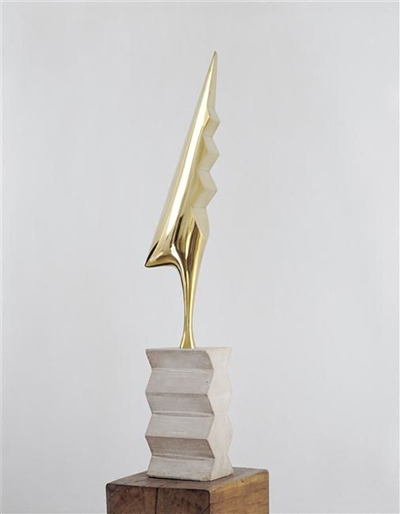Constantin Brancusi's The C*ck is a 48-inch sculpture, carved from a single piece of red cherry wood. It was carved in Paris in 1924 and is the only remaining version of a series of similar works, the earliest from 1922.
The C*ck's simple form is immediately evocative of the proud, strutting rooster. But it is not straight-forwardly figurative. This is not a model of a bird. Brancusi's early work was influenced by traditional Romanian forms and folklore, and more obviously representational.
The folkloric theme of animals is carried through here into the C*ck, though, like all of his work in Paris, it has become abstracted and non-figurative. Under the influence of Rodin, Brancusi had moved towards an attempt to capture the essence of natural objects through simplified forms. In the case of the C*ck, the rooster is clearly suggested, but in terms, here, of the bird's meaning, both as a natural creature and a social signifier.
The form of the sculpture is fundamentally a wedge shape, pointing skyward, connected to a cylindrical supporting plinth by a single stem. The wedge, stem and plinth are all carved from a single piece of wood. The wedge itself has a serrated edge on its vertical side with three gradated teeth.
This form is at once indicative of several bird-like features, most prominently the coxcomb, that extension of flesh that sits on top of the rooster's head and is its most obvious visual marker. But the form is also suggestive of feathers, perhaps of the tail, and also detached as a writer's quill. In this latter sense, the cylindrical plinth itself is reminiscent of an inkwell.
The overall shape also hints at other, non-birdlike forms, such as a saw, and more significantly, the gnomon of a sundial. The latter brings a theme of time to the work, relating to Brancusi's attempts to capture eternal essences rather than evanescent forms, with his increasingly abstract work. Brancusi was interested in birds and flight more generally, and the vertical pointing nature of the work indicates a concern with atmospheric height that is also explored in his work, 'Bird in Space'.
Perhaps the most obvious signification of the work is of the proud status of the C*ck itself, its strutting demeanour and raucous cry. Indeed the sculpture is even evocative of that strident sound. The theme here of masculine virility here was clearly close to Brancusi's heart and his self-image, leading him to say of this work, "Le Coq c'est moi" (The C*ck is me). While the 1924 cherry wood piece is the only surviving version of the C*ck, Brancusi made several others and in fact planned to produce one of monumental size. This was, however, never made.




